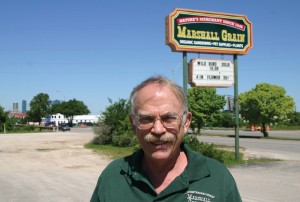Longtime Eastside resident Mae Francis Gross was buying bags of food for her dog and cat like she’s done for years at Marshall Grain when the woman behind the counter dropped a bombshell. The store is closing on June 30.
“What! No more Marshall Grain?” Gross said, visibly upset. “Why? Y’all been here so long.”
The store opened in 1946 at 2224 E. Lancaster Ave. Gross has shopped there for most of her 59 years. What started as a feed store has evolved into a place to buy organic gardening and pet supplies, both of which Gross uses regularly.
“It’s frustrating. I’m sad they’re closing,” she said. “My father and his parents used to come here. I get items for my dogs, cats, my garden, and my yard. It’s very convenient. I’ve always come here since I was a little girl.”

More stores and online sites are selling pet and organic supplies these days, so competition has increased. But it’s not hard to decipher the main reason Marshall Grain is closing its East Side store and relocating everything to its Grapevine locale. Owner Jim Connelley sent an e-mail to his customers explaining the decision: “Unfortunately, the neighborhood surrounding our Fort Worth store has been in decline for many years. Despite concerted efforts by the residents and businesses to reverse the decline, it has become gradually worse each year. Fewer and fewer customers are willing to venture into a neighborhood where the streets are roamed by panhandlers, prostitutes, and drug addicts. Nor is it a safe area for our employees, suppliers, and others needing to do business with us.”
The notice hit residents hard, serving as another reminder that businesses and neighborhoods are suffering, city officials don’t care, and the future looks bleak.
“You put all the homeless here in one place, this is what happens,” said a business owner who asked for anonymity. “What do they think? It’s going to get better?”
Shoplifting is just one of many recurring problems.
“We can’t have glass rain gauges in the store because people will take them to cook drugs in,” Connelley said. “Panhandlers in the parking lot. Streetwalkers on the street. Customers don’t want to come to a place that’s not nice. We can keep it nice inside, but we can’t control what goes on out in the street.”
Worse, he doesn’t envision things getting any better. Connelley and his wife, Joyce, have made numerous visits to city hall, attended city council and neighborhood meetings, and spoken with various officials. Little has changed.
“East Lancaster is a terrible neighborhood for retail simply because people don’t want to come here because of the crime and homeless issue,” Connelley said. “I don’t think the city is cooperating. It seems to me they’ve decided this is a good place to put the homeless problem. I don’t have an answer for what they should do. I just know what the impact has been on the business.”
After our interview, I ask Connelley to pose for a photo near his outdoor sign. As I’m taking photos, a man in an old and dilapidated car covered in black primer paint sputters into the parking lot and comes to a stop underneath the sign. The driver opens his car door, leans back in his seat, pulls his cap down over his eyes, and appears to be readying himself for a nap.
“What’s this guy up to?” I ask.
“I don’t know,” Connelley said. “People do all kinds of strange things around here.”
This part of East Lancaster falls under the purview of City Councilwoman Kelly Allen Gray, who grew up in the neighborhood. She vowed to improve the area when she first ran for election in 2012. Four years later, she sees improvements being made even if Connelley and others don’t.
“I’ve kept my promise of working on East Lancaster,” she said.
Vision East Lancaster, a group made up of neighborhood associations and business owners, discussed improvements that were needed along the seven-mile stretch of the road that lies between Riverside Drive and the Handley community. From those talks in 2013, the decision was made to build a library on East Lancaster. The city has already purchased the property and will build the library using 2014 bond money. The community wanted more police presence. City and police officials agreed to house a squad of officers in the old Channel 5 building on Broadcast Hill. A developer is currently looking at buying and rehabbing a couple of apartment complexes. City crews have improved sidewalks and built bike lanes. And another $3 million in bond money is slated to improve the traffic lights, signage, and streetlights along East Lancaster to “improve the look of the corridor,” Gray said.
Some business owners continue to complain, but others are on board, supporting the city’s efforts, Gray said.
“Lots of things are happening on the East Side,” she said. “It’s a slow process, but it’s a process we have committed to, and we’re going to see it through. Some of the issues we are experiencing on East Lancaster did not get that way overnight, and we’re not going to remedy them overnight, but we are working on it diligently every single day. It takes all of us doing our part.”
I asked Gray for the name of a business owner who is on board with the city’s efforts, and the city councilwoman mentioned Suzi Hill, owner of Gene Hill Equipment Co. The construction business is even closer to the homeless district than Marshall Grain. Hill answered her phone brightly and seemed like a nice, positive, outgoing person. She went to work at Hill Equipment on East Lancaster in 1972, bought the company in 1976, and moved a couple of miles away to Miller Avenue in 1978. At the time, East Lancaster was a nice place to work and shop and wasn’t overrun with homeless people, she said.
In 2003, the owner of the property at 1920 E. Lancaster Ave. called Hill and asked if she wanted to buy the lot and return her construction business there. The price was right. Hill took the bait.
“When I came back, I was shocked at what I had stumbled into,” she said. “But I make it work.”
The construction business doesn’t rely on walk-in customers. But a silk screening and embroidery shop opened in the same building in 2008, and the problems associated with the homeless became more apparent.
“I just didn’t realize what an impact it would have,” Hill said. “The customers do complain, but we assure them we’ve been here for many years. If we start having a problem with the homeless –– and we do –– I will text [Gray’s] office, and they have code enforcement or the police out here immediately.”
Hill’s property backs up to a railroad track not far from Sycamore Creek. Homeless people have set up camps on her land.
“They start building their tents, hauling their mattresses in, being nude and naked and going to the bathroom wherever they want to,” she said.
Just the other day, city employees bagged up several loads of discarded clothing that had been left behind. Hill said homeless people get clean clothes through the shelters and missions so easily that they throw away their dirty clothes rather than wash them.
I wondered if Hill wasn’t as supportive of the city’s efforts as Gray had indicated. Hill laughed. She is definitely supportive, she said.
“Some of us are not as fortunate as the Connelleys to be able to move away,” Hill said. “I can’t move. For what we’ve put into our property through the years and how I’ve maintained it, the value of property around here isn’t enough that I can sell it and move elsewhere. So it behooves me to have a good attitude and try to make this work.”
She stays positive because Gray and city employees appear to have her back, responding quickly whenever Hill reports problems related to the homeless population.
“Right now, I can honestly say that when I holler for help, they’re here,” she said. “It’s bad over here, but some of us are here, and we have to make the best of it and hope it is going to improve. This new lighting and streetscape will help. It’s nice the city is doing some infrastructure for us that makes us feel like we’re not stepchildren over here on the East Side.”
Tandy Hills, the potential marketing tool to reinvigorate the East Side, is a little over a mile to the east from Marshall Grain. Young and other activists have been asking the city to provide picnic tables, restrooms, and other basic amenities for years, and the city finally accommodated them. Can you guess who is using the restrooms and picnic tables more and more these days?
“If it was easy to solve the dilemma of the East Side, it would have already been done,” Tandy said. “The important thing is to know that there are solutions. It’s not impossible. I am sure about that.”












Are you trying to claim that most of the stockyards stench blew eastward? I’m not buying it, slick.
You loose Dave…both the stockyards bedraggled aroma and our cities persistent sewage perfume settled in on the East Side. The aroma, most every day, back in the day, would gag a buzzard. True. For some reason, Black folks rode in the back of our cities buses too back then, just the way things was. I headed out to the East Side pretty often to get Bar-B-Q and beer in Stop Six back then. A Black fellow named Sonny worked six days weekly fixing flats, and washing cars, and keeping the Rest Rooms tidy for my Daddy at his Gulf filling station. Sonny got $40 weekly (before taxes) for six days, ten hours daily. He was a good guy and honest and worked like a mule. I would take him home from work on Friday, buy some Bar-B-Q at a falling-down shack of a place, and Sonny would take care of gathering up a six-pack of Pearl beer for me at the same joint. I’m sorry, back to what I was saying…the packing house odor covered the East Side and it was pretty rich, I’m telling you what.
It’s 10:48pm 5/15….who do we pay to get moderated? Whose on first? What the hell?